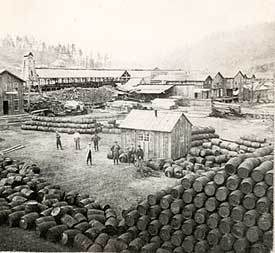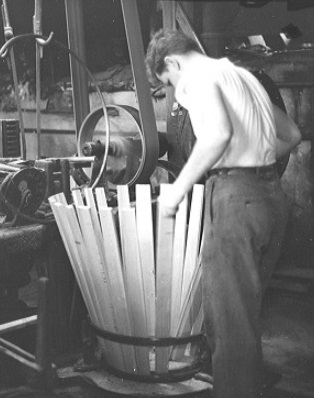19th-century coopers made barrels of many capacities: hogsheads, puncheons, tierces, butts and tuns.
Soon after America’s first commercial oil well of 1859, a small group met in northwestern Pennsylvania and decided a 42-gallon wooden barrel was best for transporting their oil.
When filled with oil instead of fish or other commodities, a 42-gallon “tierce” weighed 300 pounds. The 42-gallon oil barrel was officially adopted in 1866. Today, a barrel’s refined products include about 20 gallons of gasoline, 12 gallons of diesel and four gallons of jet fuel (and rocket fuel) and other products, including asphalt.

By the 1860s, barges floated barrels of oil down the Allegheny River to Pittsburgh to be refined into a highly demanded product – kerosene for lamps. Image from an early oil company stock certificate.
In August 1866 a handful of America’s earliest independent oil producers met in Titusville, Pennsylvania, and agreed that henceforth, 42 gallons would constitute a barrel of oil. Pennsylvania led the world in oil production as demand soared for kerosene lamp fuel.

The 42-gallon barrel standard was adopted by the Petroleum Producers Association in 1872.
Although pipelines would later challenge the oil region’s teamsters, the business of moving oil depended mostly on men, wagons, horses, flatboats, and barrels. To reach railroad stations and docks, teams of horses pulled wagons carrying as many as eight barrels of oil. Rugged northwestern Pennsylvania terrain and muddy roads added to transportation problems.
Meanwhile, as derricks multiplied, forests along Oil Creek were reduced to barrel staves by recently introduced barrel-making machinery. Hoop mills operated day and night supporting cooperages that sprang up to join in the oil boom in what would later be called “the valley that changed the world.”
Why a 42-gallon Oil Barrel?
Long before England’s King Richard III defined the wine puncheon as a cask holding 84 gallons and a tierce as holding 42 gallons, watertight casks of many sizes were crafted by “tight” coopers. A powerful guild, the Worshipful Company of Coopers, prescribed the manner of construction.
Lesser skilled craftsmen (known as slack coopers) made casks, barrels, and pails for dry goods. Practical experience and custom made the 42-gallon watertight tierce a standard container for shipping everything from eel, salmon, herring, molasses, soap, butter, wine, and whale oil. The 42-gallon barrel became a familiar 19th-century container.
Then came Edwin L. Drake’s 1859 oil discovery at Titusville, Pennsylvania, the first commercial U.S. oil well. The petroleum exploration and production boom that followed it consumed wooden tierces, whiskey barrels, casks and barrels of all sizes.

The guild of the Worshipful Company of Coopers prescribed methods for making a watertight barrel. Lesser skilled craftsmen (slack coopers) made casks and pails for dry goods.
When filled with crude oil instead of fish or other commodities, a 42-gallon tierce weighed more than 300 pounds — about as much as a man could reasonably wrestle. Twenty would fit on a typical barge or railroad flatcar. Bigger casks were unmanageable and smaller were less profitable.
Contemporary photographs show cooperages’ prodigious response to the new demand. Within a year of Drake’s discovery, oil barrels were commonly considered to hold 42 gallons according to “The Oil Fountains of Pennsylvania” in Littells’ Living Age of September 1860.
By 1866, these abundant tierce-sized barrels were the logical choice to become the industry’s standard measure. The 42-gallon standard oil barrel was officially adopted by the Petroleum Producers Association in 1872 and the U.S. Geological Survey and the U.S. Bureau of Mines in 1882.
As the 42-gallon size soon became a key part of petroleum industry transportation infrastructure, Pennsylvania’s booming oil production became linked to college football’s Heisman Trophy. Among the Titusville cooperage companies, the Oberly & Heisman Company on Bridge Street supplied barrels — and provided Michael Heisman’s son John an after-school job.
John Heisman played varsity football for Titusville High School as a guard on the varsity team from 1884 to 1887. He graduated in 1887 and went on to become the legendary football coach for whom the Heisman Trophy is named.
“Blue Barrel” Myth
Not long after forming the Standard Oil Company in Cleveland, Ohio, in 1870, John D. Rockefeller focused on efficiency and growth for his new petroleum refining business.

Technologies for making watertight casks replaced “tight” coopers and their guild. Standard Oil in 1902 introduced a steel 42-gallon barrel that kept the cask-like appearance.
Instead of buying oil barrels, Standard Oil bought tracts of oak timber, hauled the dried timber to Cleveland on its own wagons, and built the barrels in its own cooperage. Standard’s cost per wooden barrel dropped from $3 to less than $1.50. A persistent oilfield myth says that the abbreviation “bbl” for a barrel of oil resulted from Standard Oil Company’s early practice of painting their barrels blue – bbl for “blue barrel.”
However, while Ida Tarbell’s controversial 1904 History of Standard Oil Company acknowledged the “holy blue barrel,” the abbreviation “bbl” had been in use before the 1859 birth of the petroleum industry.
In the early 19th century, wooden barrels of all capacities were common containers of trade: hogsheads, puncheons, tierces, butts, tuns, and other long since forgotten terms.
Shipping manifests reveal that quantities of honey, rum, whale oil, and other commodities were shipped by the “bbl” – well before John D. Rockefeller and Standard Oil’s blue barrels. For today’s industry, the abbreviation simply signifies a 42-gallon (159 liters) unit of measure…of any color.
Learn about the history of the 55-gallon steel drum in the Remarkable Nellie Bly’s Oil Drum.
_______________________
Recommended Reading: The History of the Standard Oil Company: All Volumes (2015); Myth, Legend, Reality: Edwin Laurentine Drake and the Early Oil Industry
(2009); The Prize: The Epic Quest for Oil, Money & Power
(2008); Trek of the Oil Finders: A History of Exploration for Petroleum (1975). Your Amazon purchase benefits the American Oil & Gas Historical Society. As an Amazon Associate, AOGHS earns a commission from qualifying purchases.
_______________________
The American Oil & Gas Historical Society preserves U.S. petroleum history. Please become an annual AOGHS supporter and help maintain this energy education website and expand historical research. For more information, contact bawells@aoghs.org. © 2024 Bruce A. Wells. All rights reserved.
Citation Information – Article Title: “History of the 42-Gallon Oil Barrel.” Authors: B.A. Wells and K.L Wells. Website Name: American Oil & Gas Historical Society. URL: https://aoghs.org/transportation/history-of-the-42-gallon-oil-barrel. Last Updated: June 21, 2024. Original Published Date: December 1, 2006.



